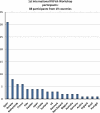Fish under exercise
- PMID: 21611721
- PMCID: PMC3107430
- DOI: 10.1007/s10695-011-9505-0
Fish under exercise
Abstract
Improved knowledge on the swimming physiology of fish and its application to fisheries science and aquaculture (i.e., farming a fitter fish) is currently needed in the face of global environmental changes, high fishing pressures, increased aquaculture production as well as increased concern on fish well-being. Here, we review existing data on teleost fish that indicate that sustained exercise at optimal speeds enhances muscle growth and has consequences for flesh quality. Potential added benefits of sustained exercise may be delay of ovarian development and stimulation of immune status. Exercise could represent a natural, noninvasive, and economical approach to improve growth, flesh quality as well as welfare of aquacultured fish: a FitFish for a healthy consumer. All these issues are important for setting directions for policy decisions and future studies in this area. For this purpose, the FitFish workshop on the Swimming Physiology of Fish ( http://www.ub.edu/fitfish2010 ) was organized to bring together a multidisciplinary group of scientists using exercise models, industrial partners, and policy makers. Sixteen international experts from Europe, North America, and Japan were invited to present their work and view on migration of fishes in their natural environment, beneficial effects of exercise, and applications for sustainable aquaculture. Eighty-eight participants from 19 different countries contributed through a poster session and round table discussion. Eight papers from invited speakers at the workshop have been contributed to this special issue on The Swimming Physiology of Fish.
Figures



References
-
- Adams CE, Huntingford FA, Krpal J, Jobling M, Burnett SJ. Exercise, agonistic behaviour and food acquisition in Arctic charr, Salvelinus alpinus. Environ Biol Fishes. 1995;43:213–218. doi: 10.1007/BF00002494. - DOI
-
- Altringham JD, Ellerby DJ. Fish swimming: patterns in muscle function. J Exp Biol. 1999;202:3397–3403. - PubMed
-
- Brown EJ, Bruce M, Pether S, Herbert NA (2011) Do swimming fish always grow fast? Investigating the magnitude and physiological basis of exercise-induced growth in juvenile New Zealand yellowtail kingfish, Seriola lalandi. Fish Physiol Biochem (this issue) - PubMed
-
- Bugeon J, Lefevre F, Fauconneau B. Fillet texture and muscle structure in brown trout (Salmo trutta) Aquacult Res. 2003;34:1287–1295. doi: 10.1046/j.1365-2109.2003.00938.x. - DOI
Publication types
MeSH terms
Substances
LinkOut - more resources
Full Text Sources

